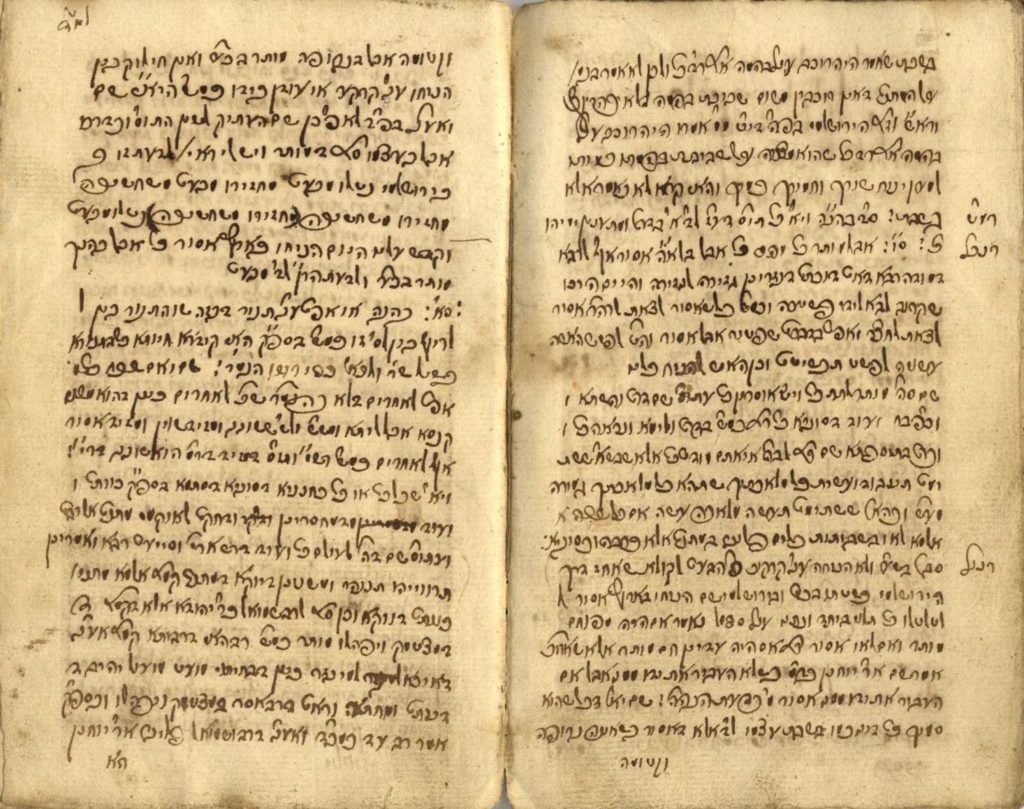
This is a very rare copy of a section of the Biur and the Likutim written by the GR”A as a supplement to his Biur on the Shulchan Aruch. Refer to Torat HaGR”A p. 492. The manuscript was in Rabbi Eliyahu Landau of Jerusalem’s collection. He was a fifth generation descendant of the GR”A’s, who opened an institute in the GR”A’s name in order to publish all the GR”A’s writings. He collected a lot of manuscripts and pasted notes on each one of them with a catalog number and description. This manuscript, numbered 26, is titled “Volume of Likutim on the Shulchan Aruch Orach Chaim from the GR”A …”
The manuscript includes 101 leaves, 16.5 cm.
The manuscript was written by a number of writers, late 18th-early 19th century. It was apparently copied from the manuscript of the GR”A himself. The manuscript was later paginated sequentially from leaf 1 through 100.
The manuscript includes:
Leaf 1-33 (script 1): Likutim on Orach Chaim, siman 1 – siman 261, with light variations from the printed version. On occasion these variations are significant – refer to Rabbi Avraham Kosman’s article in Yeshurun , volume 4, p. 78-100.
Leaf 34: blank.
Leaf 35 -42 (script 2): Elucidation on Yoreh Deah, from siman 1 through mid-siman 20. Without the Likutim, just the Biur itself. Slight variations from the printed version and a few mistakes that were corrected in the print version.
Leaf 43-52 (script 3): The Biur on Even HaEzer from siman 138 through mid-147. This follows the printed version, though it is missing some passages.
Leaf 53-100 [an additional leaf, marked 108] (script 4): Likutim on Choshen Mishpat, apparently missing the middle and end. This manuscript was not seen by the printers. It was only in the last edition published by Morashah L’Hanchil that some of the Likutim of the Biur HaGR”A were revised according to this manuscript.
Manuscripts of the Biur and Likutim of the GR”A are very rare. There are only solitary sections that are known. Refer to Torat HaGR”A for the list of known manuscripts, 520-522. (Some of this manuscript is not listed, as it was not seen by the author.) Fine condition. Aging stains. Worn binding.
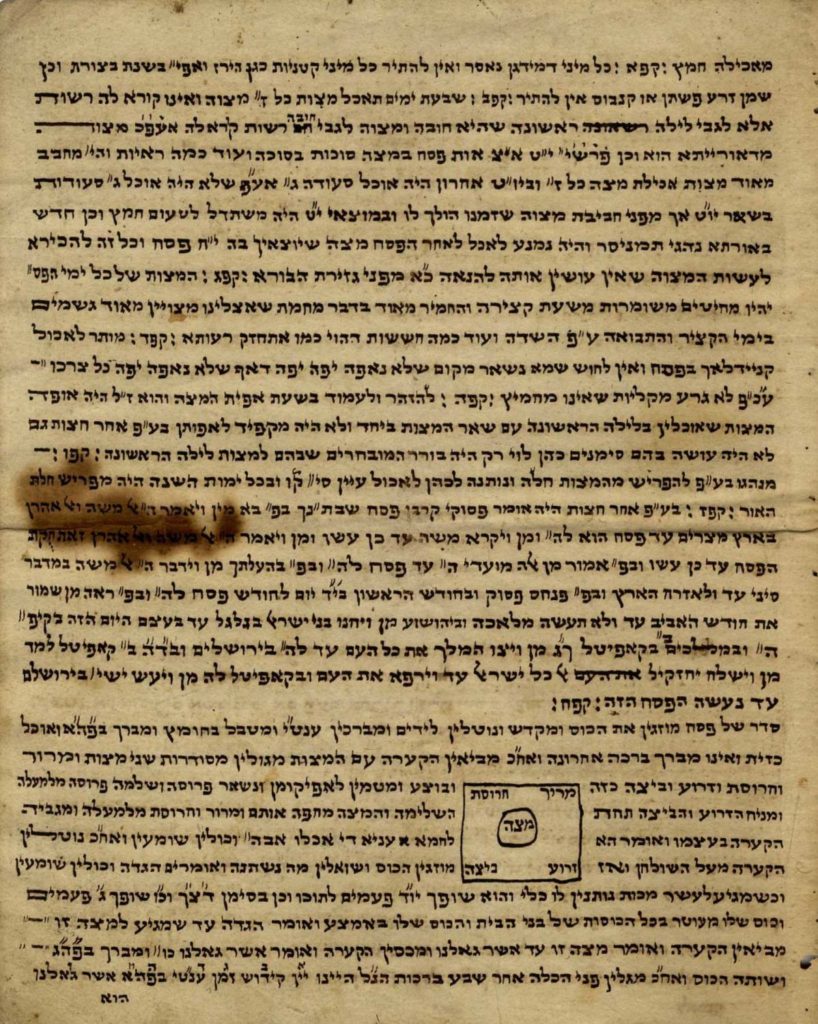
Ma’aseh Rav is a compilation of Rabbi Eliyahu of Vilna’s – “the GR”A”‘s – conduct. His customs were compiled by Rabbi Yissachar Ber, son of R’ Tanchum, in 1817, primarily according to Rabbi Saadyah, famed disciple of the GR”A, and from notes of the GR”A’s conduct. It took about fifteen years to arrange and print the work. Approbations were given back in 1817, including one from Rabbi Avraham Danzig, author of Chayei Adam and the GR”A’s mechutan. The book was revised and re-arranged for print in 1829, and finally printed in 1832 by R’ Mordechai, son of Rabbi Yissachar Ber.
During the years between the writing and the printing of this work, various copies were made, as the publisher notes in the first printed edition. This is a copy that was finished on the 24th of Av, 1828 – that is, before the book was printed. This manuscript is so important because it is one of the solitary surviving early manuscripts that preceded the printed edition. It features clear variations from the printed text and is one of the few copies that was written in a block scribal hand. In 1833, only one year after the printing of the first edition of the book, another edition was printed in Lemberg, but it was very different than the earlier edition. Some believe that the second edition was actually an earlier edition that had been prepared for print back in 1817. Over time, dozens of editions of the book have been printed, some with light variations to the text. However, in 1896, the GR”A’s progeny printed the Tosefet Maaseh Rav in Jerusalem according to the great-grandson of the GR”A’s manuscript, which was written in 1828, with many variations.
This manuscript was written in 1828 and is similar to what is considered the first edition and the Tosefet Maaseh Rav . In his article “Sefer Maaseh Rav,” Yeshurun , 21, Rabbi David Kaminetzky discusses manuscripts of Maaseh Rav that were written before the book was printed [p. 825-826]. Some of those manuscripts are incomplete. In addition, manuscripts of the “first edition” are particularly rare. This manuscript is not listed by the aforementioned article nor was it available to be studied by the researchers of the GR”A’s Torah and customs.
This manuscript features many variations in text to the printed edition, including some that are very significant. It includes variations to texts that were questioned by those who studied the GR”A’s Torah. This edition clarifies their questions.
For example:
Siman 124 discusses eating garlic on Friday night. The printed version states, “the garlic should be cooked,” which has been much discussed and questioned. But this manuscript does not say that the garlic should be cooked.
In siman 62, the printed edition reads, “Monday is completely for Hash-m,” meaning that the second day of the week is completely for Hash-m. Later generations expanded on the virtues of Monday and Thursday (not just Monday), and some even wrote that the GR”A passed away on Monday. However, this manuscript clearly writes “Monday and Thursday are completely for Hash-m.” In siman 184, regarding kitniyot on Pesach, the printed edition determines “and one should not permit hemp oil.” However, here it says that “flax and hemp seeds should not be permitted.” Siman 118 in the printed edition states, “During kiddush on wine, the bread should not be on the table.” However, this manuscript states, “during kiddush on raisin wine, the bread should be on the table.”
[12] pages. Ink on paper. Beautiful block scribal hand. Colophon at the conclusion. Fine condition. Small oily stain throughout the book’s leaves. New half-leather binding.
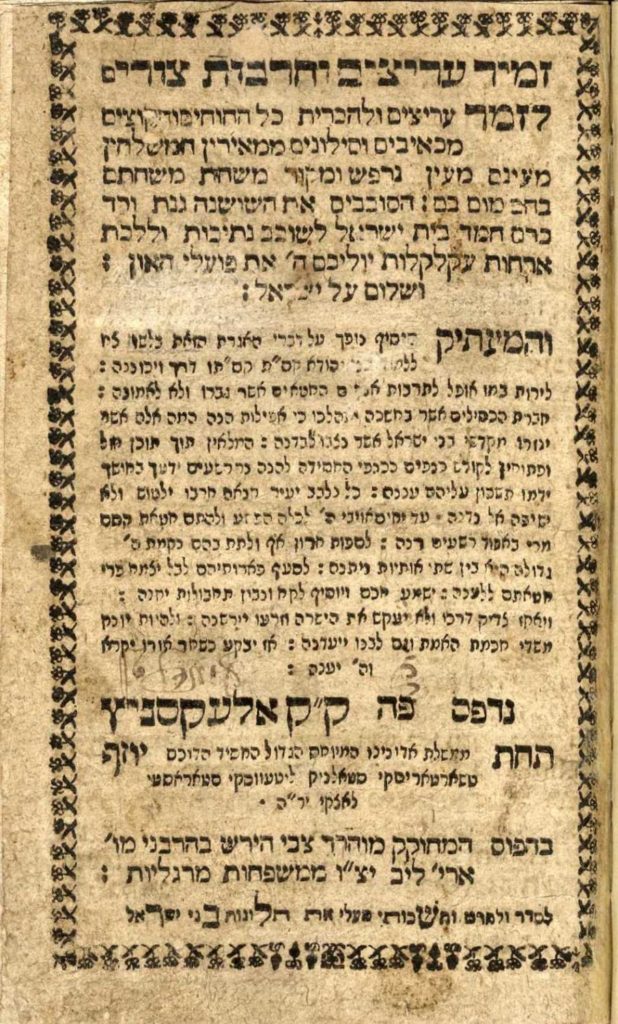
Zamir Aritzim V’Charavot Tzurim . “To prune and cut down all thorns … that surround the rose.” By R’ Aryeh Yehudah Leib of Broyde. Oleksinetz, [1772]. First book in history written to oppose the Chassidim. Work of immense historic value. Exceptionally rare. Incomplete copy.
The first publication opposing Chassidut and Chassidim. Includes proclamation of a ban against Chassidut and other documents. This work reverberated harshly throughout the Jewish diaspora and caused many Chassidim to gather together to plan an appropriate reaction and defense.
The work was printed in the summer of 1772, about a half of a year before the passing of the Maggid of Mezeritch, successor to the Baal Shem Tov as leader of the nascent Chassidic movement. The first Admor of Lubavitch, the “Baal HaTanya,” wrote about the harsh results of the book’s publication: “The book was sent all over the exile. The magnitude of derision and suffering that it caused to the famed righteous people of Wolyn is unbelievable – to the extent that they could not sit in their homes and they all came to rest in the shade of the great Rebbe (the Maggid of Mezeritch) in Rivne to confer and decide what to do.”
The work includes: Leaf 1b: “Iggeret HaKanaut” from Vilna about the first Chassidim in Vilna and their customs. Leaf 3b: Excommunication announced in Brodt in 1872. Leaf 6a: “Tosefet Biur” about the “innovators who destroy our customs.” Leaf 11b: Writings that reached the Brisk, Lithuania community from the Vilna community, signed by 15 community trustees, headed by Reb Shmuel, Av Beit Din, and the Gaon Rabbi Eliyahu of Vilna. Leaf 14b: Letter sent from Vilna to … the heads of the communities … the rabbis” by the Vilna rabbis, led by the Vilna Gaon; “Matters discussed” regarding the growth of Chassidut in the communities of Vilna, Minsk and Sklow; “Regulations of the Leshnov Community” against the “people known as Chassidim,” signed by the rabbis and leaders of Leshnov. In addition to various supplements by the copier: “… I also heard from trustworthy people by members of the holy Vilna community that they scream during prayers … and it is said in the name of the true chassid, Moreinu, Eliyahu that he knows that this is a big קליפה [blockage].”
This public opposition triggered a storm. The Chassidic community destroyed every copy that they could find and even paid a lot of money to purchase additional copies so that they could destroy them. This means that even two hundred years ago, this work was very uncommon!
About sixteen years after it was printed, in 1798, another compilation was printed with the title Zamir Aritzim , which also opposed Chassidut. However, its content is completely different; it was authored by R’ David of Makow. That booklet is better known, and so some bibliographers erroneously believed that this rare booklet was similar to the second. Refer to the National Library catalog, entry 001729888. In 1904, Ephraim Deinard printed another edition of this work. He called it ” Zamir Aritizim HaRishon ” to clarify the matter.
Much has been written about the historic significance of this work. Some even attributed it to the Vilna Gaon (!) or his disciple Rabbi Chaim of Volozhin. Today this theory has been thoroughly disproven, however it still indicates the significance of the printing of this work. Today, researchers believe that the copier was the author “Aryeh Yehudah Leib, son of Rabbi Mordechai, scribe of Brody.” There are also discussions regarding the place of print, Oleksinetz, near Brody. Some write that the publishers were a joint team from Vilna and Brody. They note the words of the Baal HaTanya “that they wrote there from Vilna” – indicating that the Vilna community was the dominant cause of the publication. Refer to Mordechai Wilensky’s study, Zamir Aritizim V’Charavot Tzurim : Critical edition by Mordechai Wilensky, in his monumental work Chassidim and Mitnagdim , I, printed in 1970.
Especially rare work. Noted bibliographer, Rabbi Chaim Lieberman, wrote: “This edition is one of the rarest books.” There is only one known complete copy in the world – the copy in the National Library in Jerusalem. This copy had been in Shlomo Dubno’s library, from where it then joined the library of collector and bibliographer Yisrael Mehlman, 1745, and he wrote, “Extremely uncommon and valuable.”
The book consists of [16] leaves. Before us are 13 leaves from the book and 3 leaves [13,15,16] in facsimile, 17 cm. Fine-very fine condition. Aging stains. New leather binding, within a beautiful linen slipcase.
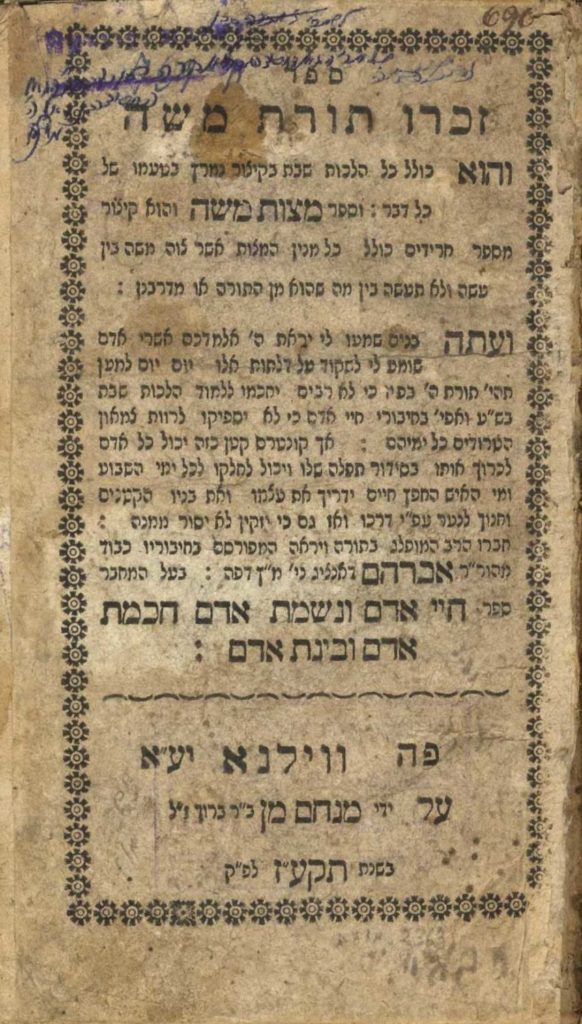
Zichru Torat Moshe by the author of Chayei Adam and Chachmat Adam . Includes all the halachahs of Shabbat in brief with a reason for each. With Sefer Mitzvat Moshe , an abridgment of the Sefer Chareidim [by R’ Elazar Azikari], including the entire counting of the mitzvot differentiating between positive and negative commandments and what is from the Torah and what is rabbinic … authored by … Avraham Danzig. Includes the author’s approbations: “He asked me to give him a short work that I wrote when my children were young, to teach them so that they would know the mitzvahs and their basics.”
Rabbi Avraham Danzig was a disciple of the Noda B’Yehudah’s and a rabbi and adjudicator in Vilna. He had a close relationship with the GR”A and describes his method of learning in his introduction.
[10], 9-51 leaves. 17.5 cm. Handwritten glosses and supplements in the margins. Moderate-fine condition. Stains. Light tear in leaf 3, blemishing solitary words.
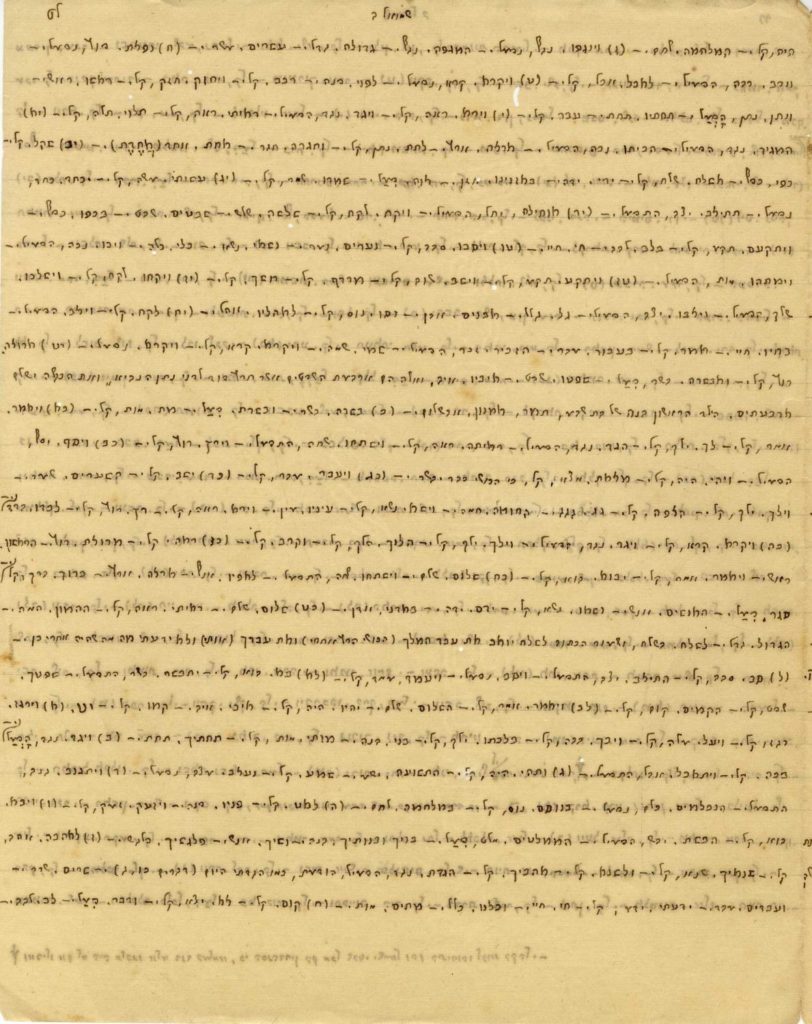
Commentary on Early Prophets: Yehoshua, Shoftim, Shmuel and Melachim. Extensive elucidation of the simple understanding and grammar, mainly a commentary on the roots of verbs. By “the GR”A’s grandson,” Rabbi Eliyahu Landau. Jerusalem, c. 1900.
Rabbi Eliyahu Landau [1873-1946] was the fifth generation of the GR”A (the gaon Rabbi Eliyahu) of Vilna. His family immigrated to Jerusalem in order to fulfill the Gaon’s will to his descendants to ascend to the Holy Land, hence he refused the recommendations of rabbinical leaders to serve as rabbi of Vilna, as he preferred to live in the Land of Israel. He was a disciple of the great leaders of Jerusalem, Rabbi Zalman Bahara”n and Rabbi Yosef Chaim Sonnenfeld. For over 50 years he was the central figure and saw himself as responsible for all that was connected to the heritage and Torah of his grandfather, the Vilna Gaon. As a result, he earned his famous nickname, “the GR”A’s grandson.” His collection of rare books is displayed separately in the Mercaz HaRav yeshivah as a special collection.
3-98 pages, with the leaf of comments. 65 leaves in total. 28 cm. The manuscript is slightly lacking. It starts with the third chapter of Yehoshua and ends in the middle of the 25th and final chapter of Melachim. Beautiful, clear handwriting with a fountain pen in black ink. Fine condition. Few tiny worming holes. Slight tears mainly in the margins, with small damage to text in a number of leaves.
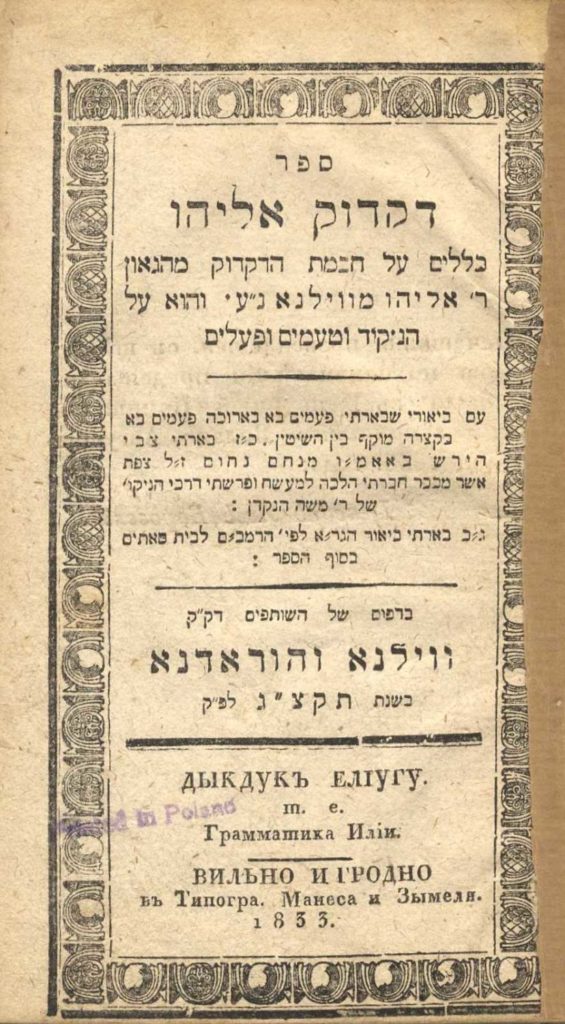
“Dikduk Eliyahu , laws of grammar from the Gaon … with my elucidation … Tzvi Hirsch son of Menachem Nachum of Safed. I have already written practical halachah and explained the vowelization technique of R’ Moshe HaNakdan, I have also explained the GR”A’s elucidation according to the Ramba”m of ‘Beit Satayim,’ at the end of the book.”
First edition of the book of grammar according to the GR”A. With the approbation of the GR”A’s grandson, Rabbi Yaakov son of Rabbi Avraham son of the GR”A. Later editions of this were called Mishpitei HaLashon HaIvrit, but they do not include all the chapters in this work. The last page features geometric elucidations with sketches.
Unique copy: The title page in this copy is different than other title pages. It is listed by the Bibliography of the Hebrew Book #000110363 according to this very copy.
[2], 24, [2] leaves. 17 cm. Vinograd, Sifrei HaGR”A 866. Very fine condition, with binding in disrepair.
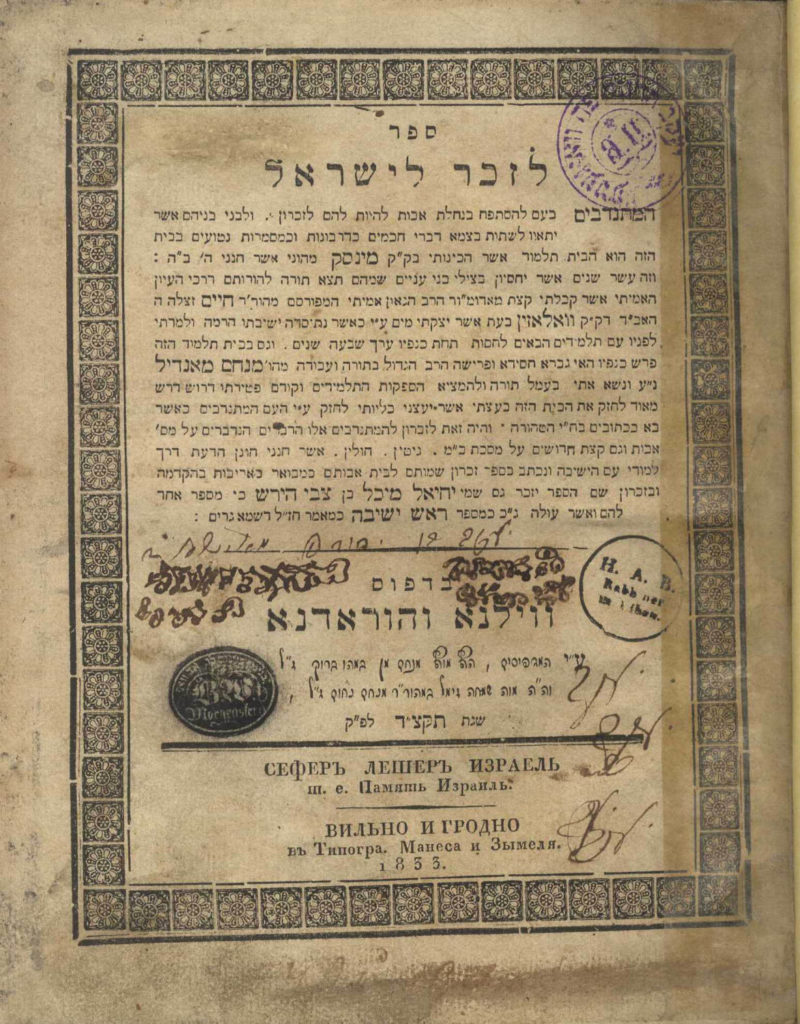
Tractate Avot with the Zecher L’Yisrael commentary and novellae on the Talmud by Rabbi Yechiel Michel of Minsk. Vilna and Grodno, 1833. Only edition. Unique copy, with bylaws regarding those worthy of being accepted into the yeshivah.
The author, Rabbi Yechiel Michel, studied in the Volozhin yeshivah and assisted Rabbi Chaim of Volozhin and then served as lecturer at the institution. He later opened his own yeshivah in Minsk. In his introduction, the author discusses the learning methods in the yeshivot. He also writes: “I served Admor HaRav Chaim of Volozhin for about seven years and I received from him some methodology and wisdom regarding the way to lead a yeshivah.”
Unique copy: This copy has an additional four leaves at the start that are not included in most copies. These leaves are listed by the Bibliography of the Hebrew Book according to a private copy. The first of these four leaves features a “Mishmeret L’Zichron HaMitnadvim” – with detailed bylaws regarding donors, including the discussion of whether donors are eligible to place their sons in the yeshivah and whether they take precedence over others. It also discusses financial concerns, the rent of the yeshivah’s apartments, and who can succeed the Rosh Yeshivah after his passing. Additionally includes exchange of written correspondence with Rabbi Yitzchak of Volozhin followed by 3 leaves of subscribers with hundreds of names from Lithuanian communities.
[4], 36; 10 leaves, 21 cm. Owner stamps. Fine condition. New binding.
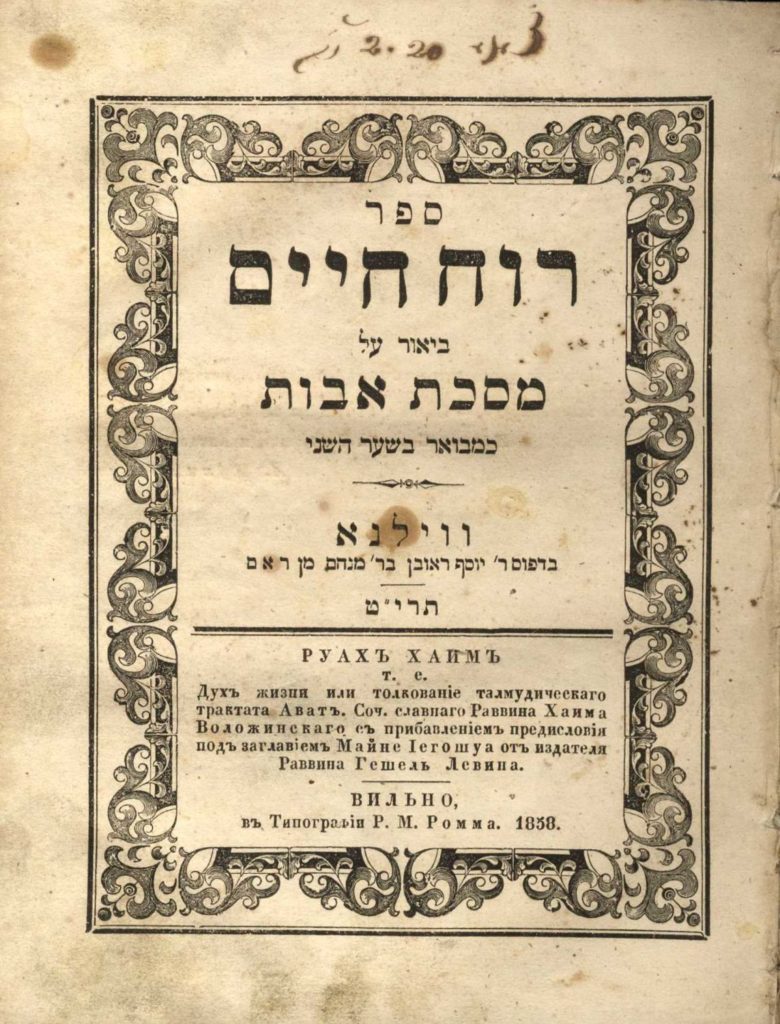
The text of Pirkei Avot is written in the center of the page, and the commentary surrounds it. The work’s manuscript was prepared to be printed during the author’s lifetime. It is mentioned in the introduction to the first edition of Nefesh HaChaim Vilna 1824, where the author’s son and successor Rabbi Yitzchak of Volozhin wrote that the work on Pirkei Avot will be called Ruach Chaim . But his son Rabbi Yitzchak did not have the privilege of publishing it in his lifetime. The author’s grandson, Rabbi Eliyahu Shlomo Zalman, Rabbi Yitzchak’s son, together with Rabbi Yehoshua Heschel Levine, published it. With an important introduction from Rabbi Avraham Simchah of Stanislaw, who was Rabbi Chaim’s disciple and nephew. He was the editor and publisher of Biur HaGR”A for Safra D’Tzniuta and Nefesh HaChaim . There is also an approbation from Rabbi Yisrael of Salant, founder of the Mussar movement.
17, 41 leaves, 20 cm. Half-title page added. Winograd, Otzar Sifrei HaGR”A , 1458. Fine-very fine condition. Aging stains.
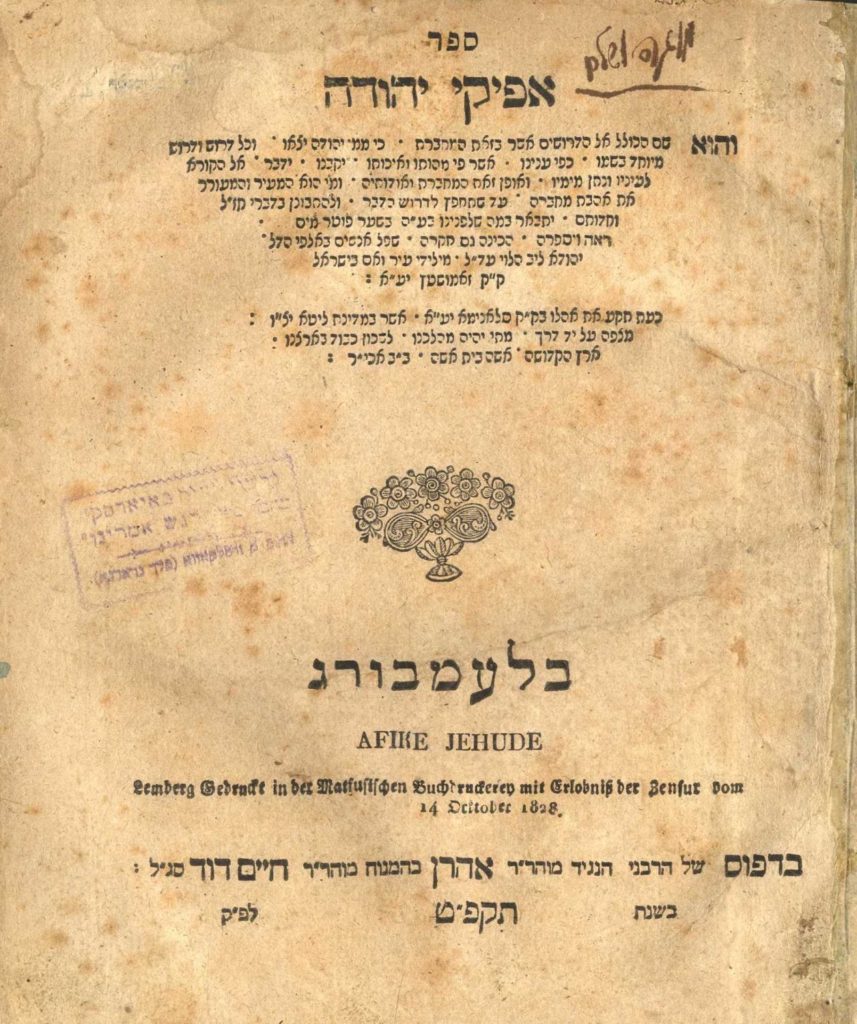
* Afikei Yehudah section I – twenty four sermons. On leaf 42a, there is a eulogy for the GR”A of Vilna “there we sat in the great synagogue of Slonima, and we wept on Wednesday, the 12th of Adar 1798”. Aharon Segal Press, Lemberg, 1829. Owner’s stamp of Rabbi “Gershon Boyarski author of Regesh Amareinu. ”
* Afikei Yehudah section II – twenty three sermons (from Sermon 25 to Sermon 48), long foreword by the author’s sons and a poem by the author. [Johannesburg, 1854]. Lacking name of press and year of printing. “Printed in Amsterdam 1827” (erroneously) written on the second title page.
By Rabbi Yehudah Leib Edel [1757-1828], preacher of Slonima. He was a close associate of the GR”A of Vilna. His sermons served as a source for sermonizers in the generations after his.
[2], 135; [10], 238 leaves. 22 cm. Moderate-fine condition. Aging stains. Few worming holes. Taped reinforcements on the last pages. Without bindings.
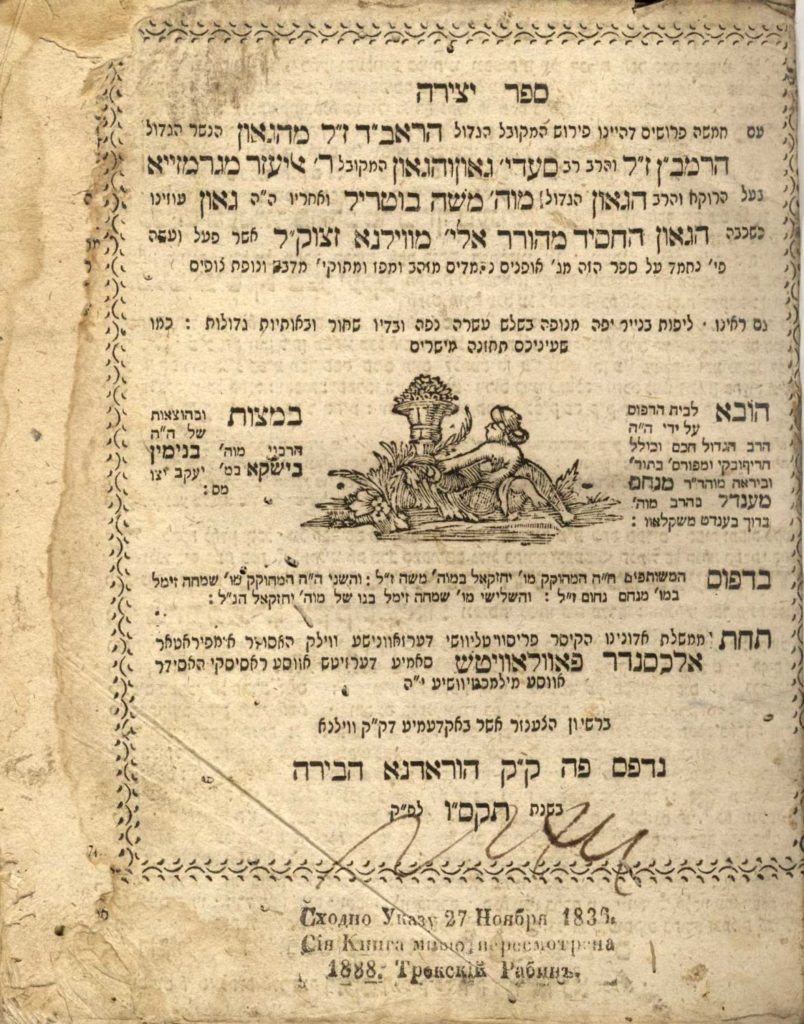
Sefer Yetzirah with Rabbi Eliyahu of Vilna’s commentary (in addition to five commentaries by: Ra”avad; Ramba”n; Rabbi Saadya Gaon; Rabbi Eliezer of Worms, the Ba’al HaRokeach; and Rabbi Moshe Butril). The book features kabbalistic charts and sketches. This edition was the first one published with the Peirush HaGR”A and is the first published kabbalistic work by the GR”A. It was printed by his disciple, kabbalist Rabbi Menachem Mendel of Sklow. At the press of Yechzkel son of Moshe, Grodno, [1806].
There are approximately 13 kabbalistic glosses in the margins of the leaves, primarily regarding the holy names and letter combinations – as known, change to one of these letters prevents a successful outcome. That is why kabbalists state that today we are not as successful in using the Sefer Yetzirah to perform such actions as they were in the past.
12 [2], 42, [30] leaves (mispaginated). 20 cm. Moderate condition. Aging stains. Worming holes. Loss to the bottom blank margins of the last six pages, with minimal blemish to text. New binding.